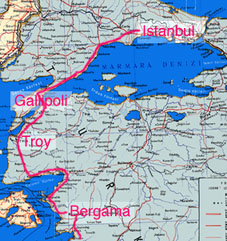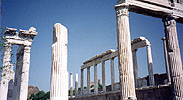 |
|
Click on any name on the route to go to the story
for that place
|
 |
|
The last few stops of the trip
|
We were up early again for the long drive to Bergama. Bergama is a town in a valley, dominated by a high hill on top of which is the Acropolis of Pergamum. (Acro-Polis means high town).
 |
| A corner of the Temple of Jupiter |
When Alexander died on his way back from the India campaign, three of his top generals split the Empire (or at least that part of it they could keep hold of). Ptolemy took Egypt, and his line lasted until the death of Cleopatra of Shakespearian fame after the Battle of Actium. Pergamum was another of the three kingdoms, but it did not last nearly as long. Around 200 BC the Pergamum King, who was considered to be mentally unbalanced anyway, gave the kingdom to the Romans in his will. The Pergamum ruins are therefore a mix of Greek and Roman
 |
 |
 |
| Views from the Pergamum Acropolis. (Left) It was poppy-time! You can see the base of a temple under the trees, with Bergama in the background. (Right) Bergama over the Greek Theatre. (Above) The view looking away from the city |
The Romans built over the Greek Acropolis, with much grander buildings then the Greek buildings of massive blocks. The Greek theatre is set into a very steep hillside. I'm not sure I would have felt safe if I had a high seat to a performance! There isn't much left of the actual buildings, even of the Roman ones, but many of the columns of the Temple of Jupiter have been restored. It must have been a magnificent sight when it was new,gleaming high on the edge of the steep hill. The hill is steep enough that there are railings to prevent tourists from falling off the edge at at least one viewpoint near where I took the middle picture below.
 |
 |
 |
| Some of the ruins on the Pergamum Acropolis. (Left) Older buildings of massive stone blocks. (Middle) The Romans built their Temple of Jupiter on top of barrel vaults that extended the platform of an earlier Greek Temple of Athena out over the steep hillside. (Right) Some of the remaining columns of the Temple of Jupiter. | ||
When we came down from the Acropolis, we passed through some different regions of town in Bergama. I don't have a picture of it, but some of what we passed through was a perfect North American inner suburb of clean bungalows in their own small gardens. The old town was rather more interesting, but of no great scenic value.
 |
 |
| Some of the older part of Bergama | Girls in typical school uniforms |
We lunched in a pleasant outdoor cafe, but the street was a fairly major one, so there was some disturbance from the traffic. It was school lunchtime, too, and we saw several groups of children, both boys and girls, in their uniforms. Since I missed taking a picture of Leyla in Perge, I took a picture of some girls on the other side of the street, to show the kind of uniforms they all seem to wear. (Here's a closer view of the same picture)
 |
 |
| The Asklepion of Aeschylus. (Above) The main street, looking back toward the Acropolis. The theatre directly faces us at the top of the hill. (Right) Ahmet strikes a pose in the communal area of the hospital. |
After lunch we visited the Asklepion of Aeschylus (the Hospital of Greek Pergamum). Hippocrates was the Chief at this hospital. The hospital grounds were laid out like a classical city, with a long colonnaded main street that led to the medical centre itself. Presumably the main street was flanked by shops and houses, but if so, they have not been excavated (so far as the tourist can see). According to Ahmet, our guide, they used therapeutic techniques that we now believe to be effective. The wards were ring-shaped, so that the doctors could circulate around the hub of the ring, while the patients' beds radiate like spokes, allowing them to be curtained off for privacy, while being accessible to the medical staff.
The wards were connected by a tunnel to a communal area, which included mineral baths like a contemporary spa, as well as the more conventional common rooms and halls. The interesting thing was that in the roof of the tunnel, which was perhaps 100 m long, there were little holes. When the patients used the tunnel, a staff member would speak through these holes, as if in the voice of a god "You are getting better" and "You will be healthy soon" and such things. This must surely have greatly aided the patient's recovery, and in the case of psychosomatic illnesses, it might have been enough to effect a complete cure.
From the hospital, it was a long drive, largely across prairie-flat agricultural land, with views of mountains to the right, and for some time views of Lesbos, one of the Greek Dodecanese Islands, which is very close to the Turkish shore. At the end of the long drive, we were at Troy.
 |
|
The logo of modern Troy--a disk found on the site.
|
 |
| The Trojan Horse (under renovation) |
Troy is famous because of Homer's Iliad, and because Heinrich Schliemann's discovery of it revolutionized our ideas of Agean history before the classical period. Until then, the Iliad was just a fine story, like one of Shakespear's plays. After Schliemann, and particularly after Schliemann discovered Mycenae and Evans discovered Knossos, the Iliad became a guide to history. Now, we are not so sure.
The Trojan War probably happened, but perhaps not all the stories in the Iliad should be assigned to the same war. Certainly the names Homer uses were good Mycenean names--but he used Mycenean names for the warriors on both sides, not just for the Greeks. And the Trojan Horse story should certainly not be taken literally. There is a good psychological interpretation of the horse story that does not assert the Trojans to be the incredibly stupid dupes that the story makes them out to be.
Troy goes back a long way, perhaps 3000 years before before the time of the Trojan War (probably about 1250 BC), and was occupied well into the Roman Empire. It occupied a very strategic spot, as the map at the top of this page shows. The harbour of Troy opened at the mouth of the Dardanelles, which allowed Troy to control the Black Sea trade. The harbour, like those of Ephesus and Mycenae has long ago silted up, and Troy is now some kilometers from the shore. But in Mycenian times, it would have been a good harbour, sheltered from the Agaean gales. I conjecture that Troy's command of the Dardanelles was the root cause of the Trojan War. (A discussion is here).
Quite apart from the Trojan War, Troy is a very interesting site, at least when visited in the company of a knowledgable guide.
|
A Roman bastion built onto the walls of Homeric Troy. The road was set between two walls, and makes a narrow right-angle turn to the left in the distance. This makes the entry easy to defend, especially against a batterming ram,, but would have made it rather hard to bring in a great wooden horse. |
An older wall, behind a bank of poppies. The place was ablaze with poppies on May 12, 2000. According to an article in Science, March 9, 2001, poppy seeds can lie dormant for a long time, and grow when the ground is disturbed. Presumably this is wht so many of the archaeological sites we visited were brilliant with them. |
 |
 |
 |
| (Left) a wall from Neolithic times (Middle) A suggestion of some of the damage Schliemann did when he drove his great trench through the middle of the mound. (Right) Part of the Roman town. | ||||
The site is a fairly high mound, one city having been built on the remains of another for maybe 4-5000 years. The mound was called Hisalik, and is one of many such mounds in Turkey. In the late 19th century, a rich entrpreneur called Heinrich Schliemann searched for a site whose geography corresponded with his understanding of the Iliad, and fixed on Hisalik as a likely spot. He hired local labour and drove a massive trench into the heart of the mound, in a way modern archaeologists consider almost scandalously destructive. Schliemann was not a trained archaeologist, but he had a vision, and only through his vision was Troy discovered at all. Through his efforts, much of what might have been learned about Troy was lost forever, but without his efforts, we might still not know of its existence.
In his digging Schliemann was looking for the "topless towers" of Ilium, the great walls and palaces. He threw away, or gave to his laboureres for building materials much of the material he unearthed, including stones now thought to be from the walls he was actually seeking. Schliemann unearthed the road shown in the picture below, and proclaimed it to be the royal entry into Homeric Troy, through which the wooden horse was dragged. But instead, it turned out to be the entrance to a less fortified city a thousand years older, very much in the manner of the grand entrance roads of similar date to the Minoan Palaces of Knossos and Phaestos. Modern archaeology has distinguished at least nine different levels of cities of distinctive shapes and character. The spacious "Homeric" city, for example, was succeeded by one in which small houses huddled together agains the old city walls.
 |
| A road Schliemann thought was the entrance to Homeric Troy, but which is in fact about 1000 years older. The wall beside it is another thousand years older still. The main gap of Schliemann's trench is on the left. The road continues straight on for a long way downhill at the same slope, until it is lost unde unexcavated ground. (If you click on this picture you will get a wide one to scroll across). |
The Homeric Troy was certainly destroyed, probably by an invading army. But the walls seem to have been destroyed by earthquake, and it may well have been their destruction, probably accompanied by considerable destruction of the city buildings, that allowed the invaders in. Were they Myceneans? The Iliad says so, but no archaeological evidence suggests a Mycenean occupation. Furthermore, around the same time or very shortly thereafter, most of the Mycenean cities fell to mysterious invaders (possibly Dorians from the north, possibly the unknown "Sea People" who were harassing Egypt). It is quite possible that the destroyers of proud Ilium were the same people who destroyed the Mycenean cities. It is more likely, however, that the Myceneans took Troy, but left their homeland in a weakened and quarrelsome state after the war, allowing the invaders to triumph in one Mycenean city after another.
After leaving Troy, we stayed overnight at a pleasant, quiet country hotel on a wooded slop leading down the the Dardanelles near Canukkale, directly across from the Gallipoli Peninsula. We walked out onto the dock, and watched at least three separate schools of myriads of tiny fish, as well as one attractive small blue fish, and many jellyfish. The relative abundance of fish did not mean, however, that the fish served at dinner was fresh and tasty!